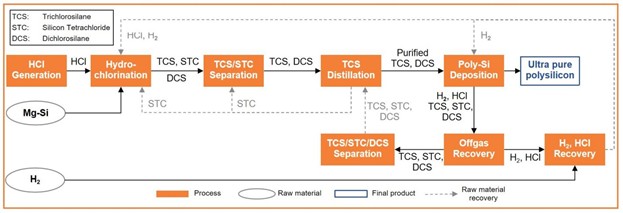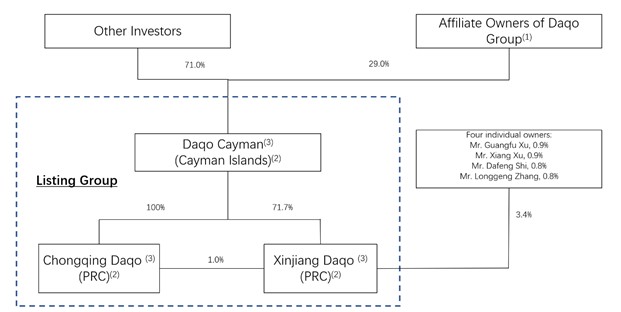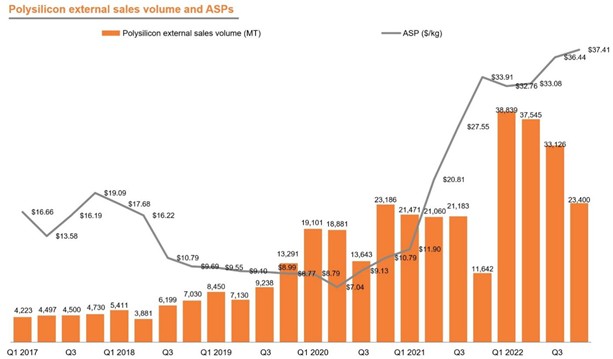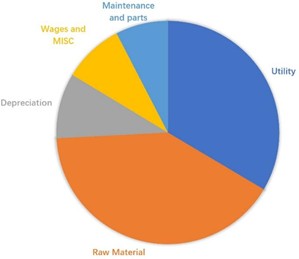Daqo Group established Daqo New Material in 2006 in Chongqing, China. Although all of Daqo Group’s equity interest holders also beneficially own shares of Daqo Cayman, Daqo Group does not have any shareholding in our company. Subsequent to the establishment of Chongqing Daqo in July 2008, Chongqing Daqo entered into a lease agreement with Daqo New Material to rent all of Daqo New Material’s land, production infrastructure, machinery, equipment, facilities, factories, buildings and other assets for polysilicon production. This lease was terminated on December 30, 2013. Under Financial Accounting Standards Board Accounting Standards Codification 810-10-15, “Variable Interest Entities,” we were deemed to be Daqo New Material’s primary beneficiary and Daqo New Material had been consolidated from July 1, 2008 to December 30, 2013. As a result of the voluntary termination of our contractual arrangements with Daqo New Material, starting from December 31, 2013, we deconsolidated Daqo New Material.
We commenced commercial production at the Phase 1 polysilicon facilities in July 2008. Production at the Phase 1 polysilicon facilities used equipment and property from both us and Daqo New Material. Even though we do not directly or indirectly hold any equity interests in Daqo New Material, under U.S. GAAP, Daqo New Material has been deemed to be our predecessor business from November 16, 2006 through June 30, 2008.
Under a non-competition agreement with us, Daqo Group has agreed not to engage in the business of manufacturing, marketing or distributing polysilicon or any other solar power products anywhere in the world or compete in any manner with our businesses without our consent for an indefinite term. Under the non-competition agreement, we, through Daqo Cayman and Chongqing Daqo, are entitled to seek temporary restraining orders, injunctions or other equitable relief, in addition to monetary remedies specified in the agreement, if Daqo Group breaches its non-competition obligations. Related party transactions are subject to our audit committee’s review and approval. With the approval of our audit committee, we gave our consent to Daqo Group to enter the photovoltaic cell manufacturing business in China. Daqo Group incorporated a wholly owned subsidiary, Zhenjiang Daqo Solar Co., Ltd., or Zhenjiang Daqo, which started commercial production of photovoltaic cells in 2011.
On October 7, 2010, we listed our ADSs, each representing five ordinary shares of Daqo New Energy Corp., on the NYSE under the symbol “DQ” in connection with an initial public offering. We issued a total of 9,200,000 ADSs at $9.50 per ADS in connection with our initial public offering.
In February 2011, we incorporated a wholly owned subsidiary, Xinjiang Daqo, in Shihezi Economic Development Area in Xinjiang Autonomous Region, China, to build our Phase 2A polysilicon production facilities. We finished construction of our Phase 2A polysilicon facilities in September 2012 and engaged in commercial production at these facilities beginning from the first quarter of 2013.
In April 2011, we incorporated a wholly owned subsidiary, Daqo New Energy Holdings (Canada) Ltd., or Daqo Canada, to expand our operations in North America. Through Daqo Canada, we set up a joint venture with JNE Solar Inc., a party unrelated to us prior to this transaction, in Hamilton, Ontario. This joint venture was terminated in April 2012. We liquidated Daqo Canada in October 2013.
In September 2012, to focus on our core businesses of polysilicon and wafer production, we sold our 100% equity interest in our module business to Daqo Group for a consideration of $9.9 million. On December 21, 2012, we effected a change of the ADS to ordinary share ratio from one ADS representing five ordinary shares to one ADS representing 25 ordinary shares. The ratio change had the same effect as a 1-for-5 reverse ADS split.
In September 2012, we halted polysilicon production in order to begin maintenance and technology improvement projects at the Phase 1 polysilicon facilities with the primary objective of lowering the cost to produce polysilicon at these facilities. In conjunction with the production stoppage, a supplementary lease agreement with Daqo New Material was reached which reduced lease payments beginning in 2013 to approximately $zero.
In the first quarter of 2013, we terminated Daqo North America, which was originally designed to promote our module products in North America. In the second quarter of 2013, we incurred fixed asset impairment charges related to the Phase 1 polysilicon facilities to reflect the market challenges that had an adverse effect on the profit-generating ability of the assets.
As of March 2013, we successfully reached our initial targets for both capacity and cost structure for our Xinjiang Phase 2A polysilicon facilities. As part of our efforts toward further improvement, we successfully completed a project to identify and reduce restrictions on our production throughput, or a “debottlenecking” project, prior to the end of 2013.



